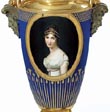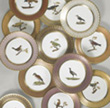| |
| |
EDITORIAL
Because it was denigrated by historians of the Third Republic as a result of the catastrophe at Sedan, and because of the need to establish the latter regime's legitimacy as the complete opposite of what had gone before, the Second Empire was a subject not to be studied in France, the only work on the period being done outside France. However post-WWII Napoleon III and his Empire have begun to emerge from France's historiographical sin-bin to become more frequently the subject of historical research. We have seen books published on the subject related to the 150th anniversary of the digging of the Suez Canal (that jewel in the crown of the Second Empire) and we also seen have an increase in works in French on the period that deal with more than just art and architectural history - such as prosopographical dictionaries and studies of Napoleon III's politics. But we hope that the exhibition on Napoleon III currently on at the Musée de l'Armée will encourage an upsurge in interest in France's remarkable Second Empire as we run up to the bicentenary of Napoleon III's birth in 2008.
Peter Hicks

|
|
|
| |
THIS MONTH'S OBJECT
Vase with portrait of Queen Hortense, porcelain by Dagoty
In 1808, King Louis had certain porcelains by Dagoty brought to Holland in order to help Dutch porcelain makers. It would seem that he also placed an order for a vase decorated with a portrait of his wife, Queen Hortense.. © Fondation Napoléon - Patrice Maurin-Berthier
© Fondation Napoléon

|
|
|
| |
DAGOTY EXHIBITION AT THE CHATEAU DE MALMAISON
The Château de Malmaison currently has an exhibition of some of the very best nineteenth-century French porcelain, in other words the output of the world-famous Dagoty Manufactory. On show are more than two hundred exquisite porcelain works of art including tea and coffee services and decorative pieces, from both public and private collections © Château de Malmaison

|
|
|
| |
PETER JACKSON TO MAKE NAPOLEONIC FANTASY FILM
Word on the street is that Peter Jackson, director of the film version of the Lord of the Rings trilogy, is interested in making a film version of the fantasy novels by Naomi Novik entitled "Temeraire". Set in the Napoleonic wars but with a strong admixture of fantasy - notably dragons - the plot has British naval Capt. Will Laurence capturing a French ship only to find on board an unhatched dragon's egg, a gift from the Emperor of China for Napoleon. The egg hatches and changes not only the course of Will Laurence's career but also that of the Napoleonic wars. A project to watch...
200 YEARS AGO
On 29 September, 1806, Napoleon, then in Mainz, gave his first orders for troops movements. «To Berthier. Write to Marshal Bernadotte and tell him to march towards Kronach, and to occupy the passes into the mountains in Saxony… »
«To Berthier. Send orders to Ney's corps to hurry their march so as to reach and gather at Nuremberg (rather than Anspach) on 3 October. Give orders to the cavalry divisions which remained to the rear that they should continue their march from Wurzburg and take up positions at Lichtenfels»
(Correspondance n°10893 and n°10894)
On 5 October, 1806, the first horse races instituted by the imperial decree of 3 Fructidor, An XIII (21 August, 1805) took place in Paris, around the Champ de Mars (where the Eiffel Tower now stands). The purpose of these races and of the re-establishment of the imperial stud farms (imperial decree of 4 July, 1806) was to promote and encourage French horse-breeding. (Moniteur, 11 October, 1806)
150 YEARS AGO
1 October, 1856, the completion of Pont de la Quarantaine (Lyons).
This iron railway bridge was 121.5 m long and 8.5 m wide and linked the two Lyons stations of Vaise and Perrache, thus making it possible for travellers to go directly from Paris to Marseilles without changing trains. (Moniteur Universel, 1 and 9 October, 1856)
On 1 October, 1856, the first instalment of the serialised version of Gustave Flaubert's Madame Bovary was published in the Revue de Paris. Finished on 1 June 1856, the novel had taken Flaubert 5 years to write. Madame Bovary famously tells the story of a young Romantic woman who bored by her bourgeois, passionless marriage has an affair and then commits suicide rather than face her shame… Although (or perhaps because?) the novel was criticised in the courts because it «outraged polite society and public and religious morality», it quickly became a best-seller.
On 4 October, 1856, a subscription was launched to raise money for a marble statue in honour of Valentin Haüy (1745-1822), the inventor and instigator of education for the blind. It was to be erected «in Paris, in front of the Imperial Institute for the young blind.»
(Moniteur, 4 October, 1856)
Wishing you an excellent, Napoleonic, week.
Peter Hicks
Historian and Web editor
THE NAPOLEON.ORG BULLETIN, No 384, 28 September - 5 October, 2006
Interested in the work of the Fondation Napoléon? Why not participate, either generally or in a specific project, by making a donation.
© this Napoleon.org weekly bulletin is published by the Fondation Napoléon. Reproduction or all or part of this bulletin is forbidden, without prior agreement of the Fondation Napoléon.

|
|
|
|
|
|
|
|
|
|
|
|
THIS WEEK in the MAGAZINE
NAPOLEON POSTERS
Want a poster of the Emperor? Here's our selection of websites.
http://www.allposters.fr
http://www.postershop.fr/
http://fr.easyart.com/
http://search.barewalls.com/
On each site type "Napoleon" and/or "Bonaparte"
WHAT'S ON
Conferences
- Napoleonic Association Conference October 2006, Greenwich, London, UK
- Luigi Emanuele Corvetto (1756-1821), financier, lawyer and politician
Genoa–Imperia, Italy
Commemorations
- Historical Bivouac 1806, Jena, Germany
Exhibitions
- Public portraits, private portraits, 1770-1830, Grand Palais, Paris, France
- Louis Bonaparte and the Leiden powder explosion, Rotterdam, Netherlands
- Adel im Wandel (Changing nobility) Exhibition in the Prinzenbau and Landeshaus Sigmaringen, Germany
- Das Königreich Württemberg 1806–1918. Monarchie und Moderne (The kingdom of Württemberg 1806–1918. Monarchy and modernity) In the old castle, Stuttgart, Germany
Confederation of the Rhine 1806 Wehrgeschichtliches Museum Rastatt, Germany
- Louis Napoleon: at the court of the first King of Holland, 1806-1810, Apeldoorn, Netherlands
Got a problem with the letter? Try the home page: http://www.napoleon.org<<
|
|




